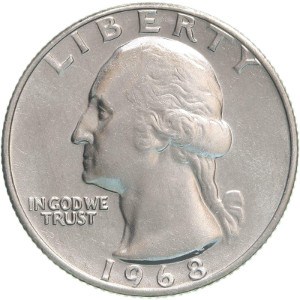The standard 1968 quarters are made of a clad composition that contains copper and nickel. The standard quarters are not valuable, however rare silver error coins could potentially be found. Keep reading to learn more about these coins.

The US minted the 1968 quarter with no mint mark and also the 1968 D quarter and 1968 S proof quarter. The mint mark, when present, can be found on the obverse side of the coin.
| Series | Location | Quantity Minted |
|---|---|---|
| 1968 | Philadelphia | 220,731,500 |
| 1968 D | Denver | 101,534,000 |
| 1968 S Proof | San Francisco | 3,041,506 |
Clad Quarters
The standard 1968 clad quarters are very common so they only sell for premiums in uncirculated condition.
The 1968 quarter with no mint mark is worth around $2.25 in uncirculated condition with a grade of MS 63. Uncirculated coins with a grade of MS 65 are valued at around $8.
The 1968 D quarter is worth around $2.25 in uncirculated condition with a grade of MS 63. Uncirculated coins with a grade of MS 65 are valued at around $6.
The 1968 S proof quarter is worth around $5 in uncirculated condition with a grade of PR 65.
Click here to search for 1968 quarters on Amazon.
Silver Error Quarters
1965 was the year that dimes and quarters changed from being 90% silver to 0% silver. So 1968 was close to a transition year. Errors get made whenever there is a big change in operating procedure.
There is one 1968 silver error quarter confirmed to exist and it's worth thousands of dollars. It's possible that more 1968 silver error quarters exist.
So how would you identify a silver quarter? It's simple. The easiest method is to weigh the coin on a calibrated gram scale. The standard clad quarters weigh 5.67 grams and the 90% silver quarters weigh 6.25 grams. You can also use the eye test. Silver quarters are shinier and they don't have any copper or nickel layers showing on the edge of the coin.
Sources:
